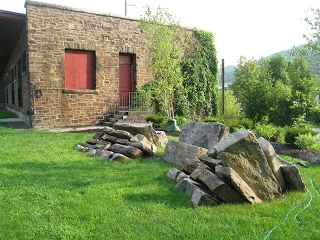Continuing on the subject of sculpture gardens, here’s a nice example I saw yesterday outside the Art Museum in Lillehammer, Norway. Created in 1992 by Bard Breivik, the sculptured garden is a cascade of stone and water. It begins serenely on flat ground at the height of the space. There, a screen of vertical granite slabs encloses a dry courtyard, a green lawn is bisected by a flagstone path, and the water course begins by spilling from a granite monolith into a long, stone trough. The water descends in multiple streams through a series of channels to a reflecting pool at the bottom of a steep rockery. Breivik’s sculptured garden is a good example of art that interprets nature without imitating it.
Read MoreDuring my working life I’ve shifted freely, back and forth, from artist to dry stone waller. Whatever the final outcome of any work, it’s been the making that I’ve liked the best. With ‘Rock Rest’, I enjoyed the creative process so much that I built the piece twice; once in my Dummerston stone yard and once here beside the museum. The stone was initially collected from a steep slope on a wooded property in Townshend. It lay there for twelve thousand years after being plucked from the ledges by the last ice age. In ‘Rock Rest’ I’ve attempted to simulate the natural process that turns bedrock into loose stone. I’ve always been fascinated by the way stones separate from one another but lock more tightly together as they slide apart.
Read More
